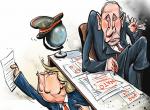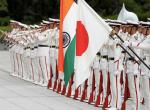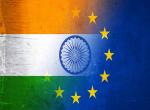Introduction
In the post-COVID era, the global geopolitical landscape has been highly unstable and marked by continuing military conflicts with far-reaching implications globally. Even the countries that are not directly participating in these wars find themselves affected by the ripple effects, including economic instability, refugee crises, heightened tensions between rival states and the possibility of nuclear escalation. These conflicts have also put strains on international relations. Additionally, the re-election of Donald Trump as US president has introduced considerable uncertainty in international relations, prompting countries to brace for potential shifts and changes in policies and alliances.
For decades, India and Russia have maintained a deep-rooted and mutually beneficial strategic partnership that has withstood the test of time, adapting to shifting global dynamics and domestic transformations. Despite geopolitical upheavals, both nations have supported each other across critical domains, including defence, energy security, and multilateral cooperation. The ongoing Russia-Ukraine conflict serves as a pivotal challenge to this enduring relationship, compelling India to navigate its foreign policy with a delicate balance of pragmatism and strategic autonomy. While New Delhi has consistently upheld its commitment to non-alignment and independent decision-making, the crisis underscores the complexities of its diplomatic engagements, particularly as it seeks to maintain constructive relations with both Russia and the West.
At the same time, this evolving geopolitical landscape presented significant opportunities for India and Russia to recalibrate and strengthen their partnership. The two countries have engaged in extensive cooperation across sectors such as defence, energy, and technology. Defence ties remain the bedrock of Russia-India relations. Over 60% of India’s military hardware originates from Russia, including advanced platforms like the S-400 missile defence system. Joint ventures, such as the BrahMos missile project, highlight the technological synergy between the two nations. However, India’s diversification of arms procurement—driven by its Make in India initiative and growing partnerships with the U.S. and France—raises questions about the future trajectory of defence collaboration.
Russia’s vast reserves of oil and gas complement India’s energy demands, making energy cooperation a critical pillar of their relationship. Recent agreements, such as Rosneft’s supply deals with Indian refiners and India’s investments in Russian oil fields, underscore mutual benefits. Moreover, collaboration in nuclear energy, exemplified by the Kudankulam Nuclear Power Plant, highlights the strategic depth of their partnership.
Bilateral trade between the two countries hit a record USD 66 billion in 2024, reflecting a fivefold increase over the past five years, with a 9 percent rise in the first eight months of this year. Russia and India are poised to reach an ambitious trade target of USD 100 billion by 2030, bolstered by expanding collaborations and diverse trade opportunities. Recent discussions between the leaders of both nations on diversifying the trade portfolio and enhancing investments across various sectors could make the USD 100 billion target by 2030 attainable. Currently, a significant portion of bilateral trade centres around oil due to discounted prices. To maintain this growth trajectory in trade, diversification is essential. Several untapped sectors, such as agriculture and science and technology, hold substantial potential for growth.
The enhancement of cultural exchange and people-to-people ties and tourism plays a strategic role in strengthening diplomatic relations and fostering long-term partnerships. The focus on tourism not only boosts the economies of both nations but also serves as a platform for showcasing cultural heritage and values. This soft power approach can significantly influence public perception and international relations, creating a favourable environment for diplomatic negotiations and trade agreements. Moreover, the recognition of the importance of technology and cybersecurity positions both countries at the forefront of global innovation. Joint ventures in emerging technologies such as artificial intelligence, renewable energy, and data protection enhance their competitive advantage and ensure mutual security in an increasingly digital world. This can lead to the development of robust frameworks that address shared challenges, such as cyber threats and technological governance.
Both nations prioritize the fight against terrorism, particularly in the context of Afghanistan and Central Asia. The rise of extremist groups following the U.S. withdrawal from Afghanistan has heightened security concerns, with both countries worried about spillover effects. Mechanisms such as the Shanghai Cooperation Organization (SCO) provide a platform for joint counterterrorism initiatives, but differences in their approaches—such as Russia’s closer ties with Pakistan and India’s mistrust of Islamabad—pose challenges to seamless cooperation. Additionally, Russia's concept of a multipolar world resonates with India's goals to promote a balanced global order, free from the influence of any one dominant power. Initiatives like the International North-South Transport Corridor (INSTC), Chabahar project and the Eurasian Economic Union (EAEU) aim to foster greater economic integration and reduce dependency on traditional trade routes. India’s involvement in these projects signals its intent to deepen its Eurasian engagement while counterbalancing China’s Belt and Road Initiative (BRI).
The China Factor
China’s growing influence is creating complex geopolitical challenges for Russia and India. For Russia, China is seen as an important ally in countering Western power and promoting an anti-West international order. This has resulted in closer military cooperation and stronger economic ties between the two nations, as they align their interests against Western dominance. On the other hand, India is concerned about China's aggressive geopolitical objectives. This sets up a tricky relationship among Russia, India, and China. Each country is trying to balance its own interests while managing interactions with the others in a complicated global environment. The delicate nature of these relations highlights the difficulties of collaboration when national goals diverge. In the aftermath of the Galwan Crisis, the relationship between India and China has significantly deteriorated, drawing concern from Moscow. However, the recent thaw in relations between Beijing and New Delhi has been met with approval and optimism by Russia, highlighting the potential for renewed diplomacy and cooperation in the region.
Challenges
Russia’s growing alignment with China presents a strategic challenge for India. Joint military exercises and economic cooperation between Moscow and Beijing are perceived in New Delhi as potential threats to its regional interests. Similarly, India’s closer ties with the U.S. through initiatives like the Quad (Quadrilateral Security Dialogue) and its Indo-Pacific strategy contrast with Russia’s pivot towards China and its resistance to Western alliances. Balancing these alignments requires diplomatic finesse to avoid antagonizing either partner. Western sanctions on Russia have indirectly impacted India’s engagement with Moscow, complicating financial transactions and trade logistics. Navigating these constraints without jeopardizing its global standing remains a delicate task for India.
Future Outlook
The future of Russia-India relations hinges on their ability to adapt to emerging challenges and capitalize on mutual opportunities. Key scenarios include:
- Deepening and Diversifying Economic Integration: Expanding the trade basket and leveraging mechanisms like the INSTC and Chabahar can enhance economic ties. It is crucial that India finalizes its Free Trade Agreement (FTA) with the Eurasian Economic Union (EAEU) without delay.
- Strategic Autonomy:Both nations must continue to assert their strategic autonomy, resisting overdependence on any single global power.
- Collaborative Security Frameworks: Strengthening platforms like the SCO and BRICS can foster cooperative security measures in Eurasia, balancing regional dynamics. Russia and India can cooperate more closely in these multilateral organisations.
- Technological Collaboration: Joint investments in emerging technologies, such as AI, space exploration, and green energy, could diversify and deepen their partnership.
Conclusion
Russia and India share a historically rooted and strategically significant relationship that continues to influence the security and stability of Eurasia. While challenges such as diverging global alignments and the China factor complicate their partnership, mutual interests in defence, energy, and multilateralism provide a strong foundation for continued collaboration. By navigating these complexities with pragmatism and foresight, Russia and India can sustain their relevance as key players in the evolving global order.
(The paper is the author’s individual scholastic articulation. The author certifies that the article/paper is original in content, unpublished and it has not been submitted for publication/web upload elsewhere, and that the facts and figures quoted are duly referenced, as needed, and are believed to be correct). (The paper does not necessarily represent the organisational stance... More >>
Image Source: https://www.pmindia.gov.in/wp-content/uploads/2024/07/H20240709162388.jpg











Post new comment